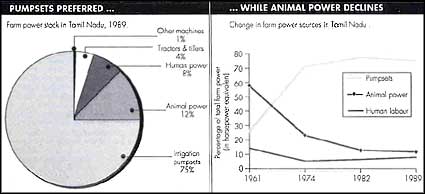Indian farms rely more on mechanical power
 THE INDIAN National Congress -- the political party that led the country to independence -- had as its election symbol during the 1950s two bullocks, to symbolise the relationship between animal draught power and Indian farming. But now, under the impact of agricultural modernisation, that relationship is now changing.
THE INDIAN National Congress -- the political party that led the country to independence -- had as its election symbol during the 1950s two bullocks, to symbolise the relationship between animal draught power and Indian farming. But now, under the impact of agricultural modernisation, that relationship is now changing.
A study by S Rajendran of the Institute for Social and Economic Change, on changing farm power patterns in villages in Tamil Nadu shows that farm power in the state has grown dramatically from 3.2 million horsepower (hp) in 1961 to 10.1 million hp in 1989. Farmers have as much as 1.69 hp/ha, as compared to 0.86 hp/ha recommended by the National Commission on Agriculture. The number of irrigation pumpsets has also risen sharply, partly because of the free electricity provided to farmers.
Animal draught power today constitutes only 12 per cent of Tamil Nadu's total farm power. Though larger farmers depend more on mechanical power, marginal and small farmers still rely heavily on biological -- animal and human -- power because they lack the funds to invest in machine power or even hire farm machines.
But to use animal power effectively, it is necessary to have good implements. If local artisans were properly trained and capital for suitable implements was available, even bigger farmers could go back to animal draught power, thus saving valuable electricity.
